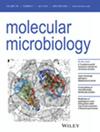来自解淀粉芽孢杆菌的单功能FMN核糖开关结合调节剂RibR促进核黄素的生物合成。
IF 2.6
2区 生物学
Q3 BIOCHEMISTRY & MOLECULAR BIOLOGY
引用次数: 0
摘要
黄素单核苷酸(FMN)核糖开关是在许多细菌中发现的基于rna的调控元件。FMN核开关控制负责核黄素生物合成和运输的基因(rib基因)。核黄素(维生素B2)是黄素酶辅助因子FMN和黄素腺嘌呤二核苷酸(FAD)的前体,FMN核开关将FMN(而不是核黄素或FAD)视为黄素稳态的信号。当FMN水平足够时,肋骨基因的表达被FMN核糖开关关闭。来自革兰氏阳性杆菌枯草芽孢杆菌的双功能蛋白RibR含有酶和调控部分,当细胞遇到特定硫源时被诱导。在这些条件下,枯草芽孢杆菌RibR与FMN核开关结合,推翻其遗传决定,并刺激肋骨基因表达。在枯草芽孢杆菌中,这种ribr介导的上级控制的目的是将硫代谢与核黄素代谢联系起来。枯草芽孢杆菌RibR是以前唯一已知的核糖开关调节蛋白。我们现在报道了一种类似但功能单一的解淀粉芽孢杆菌蛋白。B. amyloliquefaciens的RibR仅包含一个调控/ rna结合部分,并且RibR的表达不受硫源的刺激,而是受产生二硫化物和诱导氧化应激的化合物二胺的刺激。ribr样调节蛋白可能比预期的更广泛,并且显然已经进化到将核糖体开关控制的途径连接到其他途径。本文章由计算机程序翻译,如有差异,请以英文原文为准。
The Monofunctional FMN Riboswitch-Binding Regulator RibR From Bacillus amyloliquefaciens Promotes Riboflavin Biosynthesis.
Flavin mononucleotide (FMN) riboswitches are RNA-based regulatory elements found in many bacteria. FMN riboswitches control genes responsible for the biosynthesis and transport of riboflavin (rib genes). Riboflavin (vitamin B2) is the precursor of the flavoenzyme cofactors FMN and flavin adenine dinucleotide (FAD), and it is FMN (not riboflavin or FAD) that is perceived by FMN riboswitches as a signal with regard to flavin homeostasis. When FMN levels are adequate, expression of rib genes is shut down by FMN riboswitches. The bifunctional protein RibR from the Gram-positive bacterium Bacillus subtilis contains an enzymatic and a regulatory part and is induced when cells encounter specific sulfur sources. Under these conditions, B. subtilis RibR binds to FMN riboswitches, overrides their genetic decisions, and stimulates rib gene expression. In B. subtilis, the objective of this RibR-mediated superordinate control is to link sulfur metabolism to riboflavin metabolism. B. subtilis RibR was previously the only known riboswitch-modulating protein. We now report on a similar but monofunctional protein from Bacillus amyloliquefaciens. RibR from B. amyloliquefaciens contains a regulatory/RNA-binding part only, and ribR expression is not stimulated by sulfur sources but by the disulfide-generating and oxidative stress-inducing compound diamide. RibR-like regulator proteins may be more widespread than anticipated and apparently have evolved to connect riboswitch-controlled pathways to other pathways.
求助全文
通过发布文献求助,成功后即可免费获取论文全文。
去求助
来源期刊

Molecular Microbiology
生物-生化与分子生物学
CiteScore
7.20
自引率
5.60%
发文量
132
审稿时长
1.7 months
期刊介绍:
Molecular Microbiology, the leading primary journal in the microbial sciences, publishes molecular studies of Bacteria, Archaea, eukaryotic microorganisms, and their viruses.
Research papers should lead to a deeper understanding of the molecular principles underlying basic physiological processes or mechanisms. Appropriate topics include gene expression and regulation, pathogenicity and virulence, physiology and metabolism, synthesis of macromolecules (proteins, nucleic acids, lipids, polysaccharides, etc), cell biology and subcellular organization, membrane biogenesis and function, traffic and transport, cell-cell communication and signalling pathways, evolution and gene transfer. Articles focused on host responses (cellular or immunological) to pathogens or on microbial ecology should be directed to our sister journals Cellular Microbiology and Environmental Microbiology, respectively.
 求助内容:
求助内容: 应助结果提醒方式:
应助结果提醒方式:


